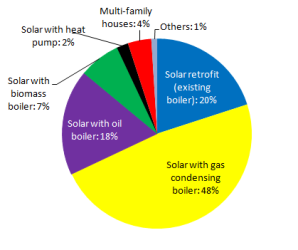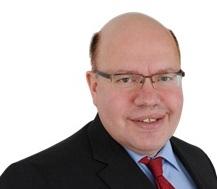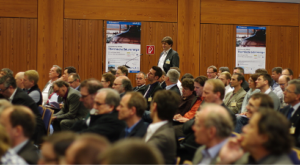Germany: Association and Ministry Discuss Market Development
May 28, 2012
 The symposium “Solar Thermal Energy” – the largest German-speaking conference dedicated to solar heating and cooling technology – has painted a mixed picture of the current development in Germany. The 3-day event, which was organised by German company Otti and took place at the beginning of May, gathered 430 researchers and industry representatives from Austria, Germany and Switzerland. The keynote speakers from the German Federal Environment Ministry, as well as from the national and international associations devoted most of their presentation time to analysing the German market. Their 2012 forecast: A 10 % plus, resulting in a newly installed solar thermal capacity of 980 MWth (1.4 million m²). The chart depicts the potential share of different heating systems combined with solar in 2012.
The symposium “Solar Thermal Energy” – the largest German-speaking conference dedicated to solar heating and cooling technology – has painted a mixed picture of the current development in Germany. The 3-day event, which was organised by German company Otti and took place at the beginning of May, gathered 430 researchers and industry representatives from Austria, Germany and Switzerland. The keynote speakers from the German Federal Environment Ministry, as well as from the national and international associations devoted most of their presentation time to analysing the German market. Their 2012 forecast: A 10 % plus, resulting in a newly installed solar thermal capacity of 980 MWth (1.4 million m²). The chart depicts the potential share of different heating systems combined with solar in 2012.
Source: BDH
The official market statistics of the renewable industry association BSW Solar and the heating industry association BDH show a small growth of 7.4 % in the first quarter compared to the same period last year. Together with increasing energy prices, the positive trend is reason enough for the association to be optimistic about this year’s market performance assuming a 10 % plus.
|
Newly installed solar thermal capacity |
889 MWth |
|
Newly installed solar thermal collector area |
1.27 million m² |
|
Number of newly installed solar thermal systems |
149,000 |
|
Growth rate 2010/2011 |
10 % |
|
Turnover of solar thermal industry |
EUR 1 billion |
 Share of measures to meet the requirement of the federal Renewable Energy Heating Law (EEWärmeG) in 2010
Share of measures to meet the requirement of the federal Renewable Energy Heating Law (EEWärmeG) in 2010
Source: German Environmental Ministry
According to yet unpublished figures from the Environment Ministry’s field report on the EEWärmeG, only 20 % of the newly built houses in Germany in 2010 implemented solar thermal technology, in order to meet the law’s requirements (see chart above). Heat pumps were installed in 27 % of the buildings, 7 % covered the demand with biomass boilers. The ministry states that the share of solar thermal in newly built structures had been constantly growing over the last ten years, with only 5 % of new houses having used solar thermal in 2002. Alternative measures, such as more insulation, the use of waste heat, or connections to heating grids, were used within at least 46% of the newly built houses in 2010.


